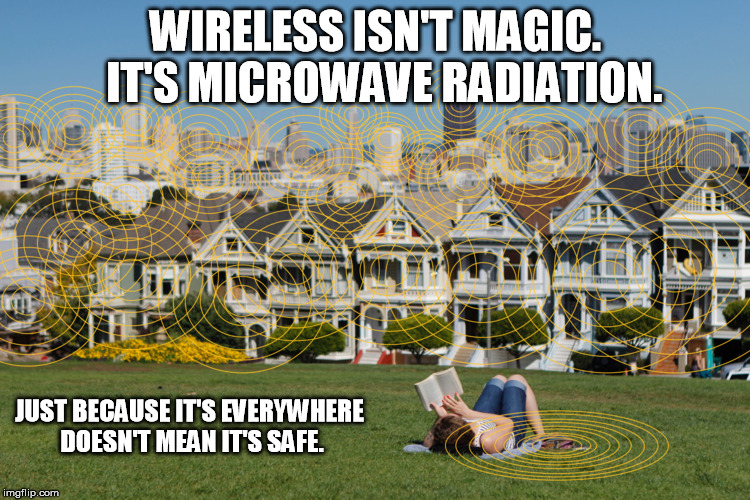 By B.N. Frank
By B.N. Frank
High-speed broadband can be achieved more safely and securely with hardwired internet connections (see 1, 2). Additionally, a group of telecom experts who call themselves The Irregulators have proven that Americans have already paid for high-speed broadband deployment via safer and more secure copper landlines and fiber optics to the premises (FTTP) (see 1, 2) rather than less safe and less secure biologically and environmental harmful Wi-Fi and 5G. Nevertheless, various government agencies including the U.S. Department of Agriculture as well as the Biden Administration continue allocating funds for broadband deployment. D’oh!
From Ars Technica:
US allocates $42B in broadband funding—find out how much your state will get
Texas and California lead way as 19 states will get at least $1 billion each.
The Biden administration today announced how much broadband-deployment funding each US state and territory will be eligible to receive from a $42.45 billion grant program.
The Broadband Equity, Access, and Deployment (BEAD) program was approved by Congress in November 2021 and will pay Internet service providers to expand networks in unserved and underserved areas. The BEAD money is being distributed to states by the National Telecommunications and Information Administration (NTIA).
Texas leads the way with $3.31 billion in today’s allocations, followed by California with $1.86 billion. Nineteen states will get at least $1 billion.
“High-speed Internet is no longer a luxury… Yet, more than 8.5 million households and small businesses are in areas where there is no high-speed Internet infrastructure, and millions more struggle with limited or unreliable Internet options,” a White House announcement said today.
Grants are intended for networks offering at least 100Mbps download speeds, 20Mbps upload speeds, and latency of no more than 100 milliseconds. After receiving money from the federal government, states will distribute grants to ISPs through competitive processes. Comparing the BEAD grants to rural electrification, the White House said that “President Biden and Vice President Harris are delivering on their historic commitment to connect everyone in America to reliable, affordable high-speed Internet by the end of the decade.”
FCC map errors still a problem
Each state will decide how to spend the money, but they must get approval for their plans from the NTIA. The agency said today:
States, D.C., and territories (“Eligible Entities”) will receive their formal notice of allocation on June 30, 2023. Under the Bipartisan Infrastructure Law, Eligible Entities have 180 days from the date of that formal notice to submit their Initial Proposals describing how they propose to run their grant programs. Eligible Entities can begin submitting their Initial Proposals starting July 1, 2023. Once NTIA approves an Initial Proposal, which will occur on a rolling basis, Eligible Entities will be permitted to request access to at least 20 percent of their allocated funds.
The timing is controversial because the funding decisions were based on the Federal Communications Commission’s broadband availability map, which relies on coverage claims submitted by ISPs. While the map is much more detailed than previous versions, it’s not totally reliable because Comcast and other ISPs have claimed to cover homes where they don’t offer service.
The FCC has a challenge process to correct false claims and mistakes, but officials from some states and some US senators have said the grants should have been delayed to allow more time for corrections. The NTIA stuck to its plan, saying that “a delay in the timeline would mean a delay in providing funding to communities who desperately need it.”
States don’t need to spend the money right away. The 180-day period noted by the NTIA will give states more time to do their own research on broadband availability and incorporate updates from the FCC, which has said it will release improvements to the national map on an ongoing basis.
While big telecoms could get most of the funding, smaller providers including municipal networks will be in the running, too. The National Rural Electric Cooperative Association praised the grant program today and said there are already over 200 electric cooperatives “working to bring broadband to their rural communities.”
How much each state will get
The allocations for each state and territory are as follows:
- Alabama: $1,401,221,901.77
- Alaska: $1,017,139,672.42
- Arizona: $993,112,231.37
- Arkansas: $1,024,303,993.86
- California: $1,864,136,508.93
- Colorado: $826,522,650.41
- Connecticut: $144,180,792.71
- Delaware: $107,748,384.66
- District of Columbia: $100,694,786.93
- Florida: $1,169,947,392.70
- Georgia: $1,307,214,371.30
- Hawaii: $149,484,493.57
- Idaho: $583,256,249.88
- Illinois: $1,040,420,751.50
- Indiana: $868,109,929.79
- Iowa: $415,331,313.00
- Kansas: $451,725,998.15
- Kentucky: $1,086,172,536.86
- Louisiana: $1,355,554,552.94
- Maine: $271,977,723.07
- Maryland: $267,738,400.71
- Massachusetts: $147,422,464.39
- Michigan: $1,559,362,479.29
- Minnesota: $651,839,368.20
- Mississippi: $1,203,561,563.05
- Missouri: $1,736,302,708.39
- Montana: $628,973,798.59
- Nebraska: $405,281,070.41
- Nevada: $416,666,229.74
- New Hampshire: $196,560,278.97
- New Jersey: $263,689,548.65
- New Mexico: $675,372,311.86
- New York: $664,618,251.49
- North Carolina: $1,532,999,481.15
- North Dakota: $130,162,815.12
- Ohio: $793,688,107.63
- Oklahoma: $797,435,691.25
- Oregon: $688,914,932.17
- Pennsylvania: $1,161,778,272.41
- Rhode Island: $108,718,820.75
- South Carolina: $551,535,983.05
- South Dakota: $207,227,523.92
- Tennessee: $813,319,680.22
- Texas: $3,312,616,455.45
- Utah: $317,399,741.54
- Vermont: $228,913,019.08
- Virginia: $1,481,489,572.87
- Washington: $1,227,742,066.30
- West Virginia: $1,210,800,969.85
- Wisconsin: $1,055,823,573.71
- Wyoming: $347,877,921.27
- American Samoa: $37,564,827.53
- Guam: $156,831,733.59
- Northern Mariana Islands: $80,796,709.02
- Puerto Rico: $334,614,151.70
- US Virgin Islands: $27,103,240.86
Despite growing American opposition to 5G and wireless deployment, some lawmakers continue supporting it anyway, most recently with a new bill that may actually worsen the “Digital Divide.” Groups opposed to this bill include the U.S. Conference of Mayors.
Activist Post reports regularly about broadband. For more information, visit our archives and the following websites:
- The Irregulators
- Americans for Responsible Technology
- Children’s Health Defense
- Environmental Health Trust
- Electromagnetic Radiation Safety
- Physicians for Safe Technology
Top image: Pixabay
Become a Patron!
Or support us at SubscribeStar
Donate cryptocurrency HERE
Subscribe to Activist Post for truth, peace, and freedom news. Follow us on SoMee, Telegram, HIVE, Flote, Minds, MeWe, Twitter, Gab, What Really Happened and GETTR.
Provide, Protect and Profit from what’s coming! Get a free issue of Counter Markets today.


Be the first to comment on "Biden Admin Announces How Much $ Each State Will Get for Broadband Deployment (List Included)"